Views: 0 Author: Site Editor Publish Time: 2025-07-11 Origin: Site











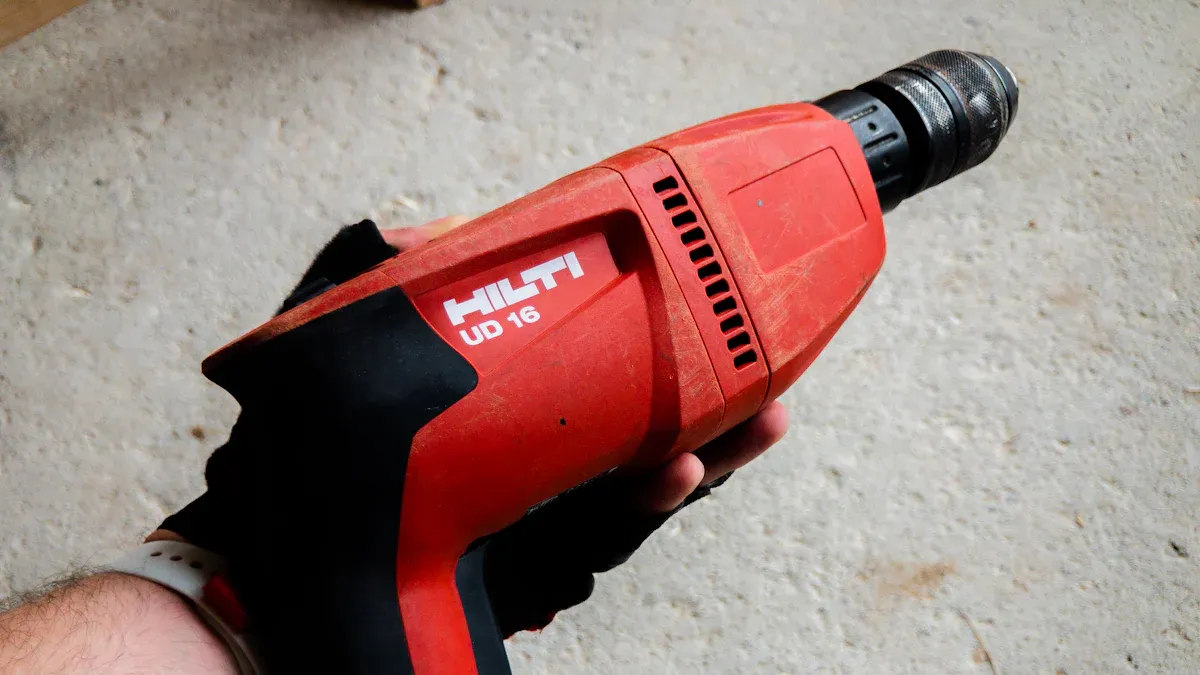
When you look for the best hammer drill for your home, you want a tool that matches your needs. You may use power drills for diy projects or heavy tasks around the home. Some people pick a cordless drill for quick jobs, while others choose corded power tools for more demanding work. A good hammer drill helps you break through tough materials. You need to check features that make each hammer or drill stand out. MINGPU offers reliable hammer drills and other power tools for your home or job site. The right hammer or power drills can make your work easier and safer.
Choose the right drill type based on your tasks: cordless drills offer mobility for light jobs, while corded hammer and rotary hammers provide steady power for heavy-duty work.
Look for key features like power (wattage), impact energy, vibration control, and chuck type to ensure your hammer drill performs well and feels comfortable during use.
Match your drill choice to the material you work with; use hammer drills or rotary hammers for masonry and concrete, and cordless or standard drills for wood and light tasks.
Prioritize safety by wearing protective gear, reading the manual, and maintaining your drill regularly to keep it working safely and efficiently.
Invest in trusted brands like MINGPU that offer reliable tools with good warranties, support, and useful accessories to get the best value and performance.
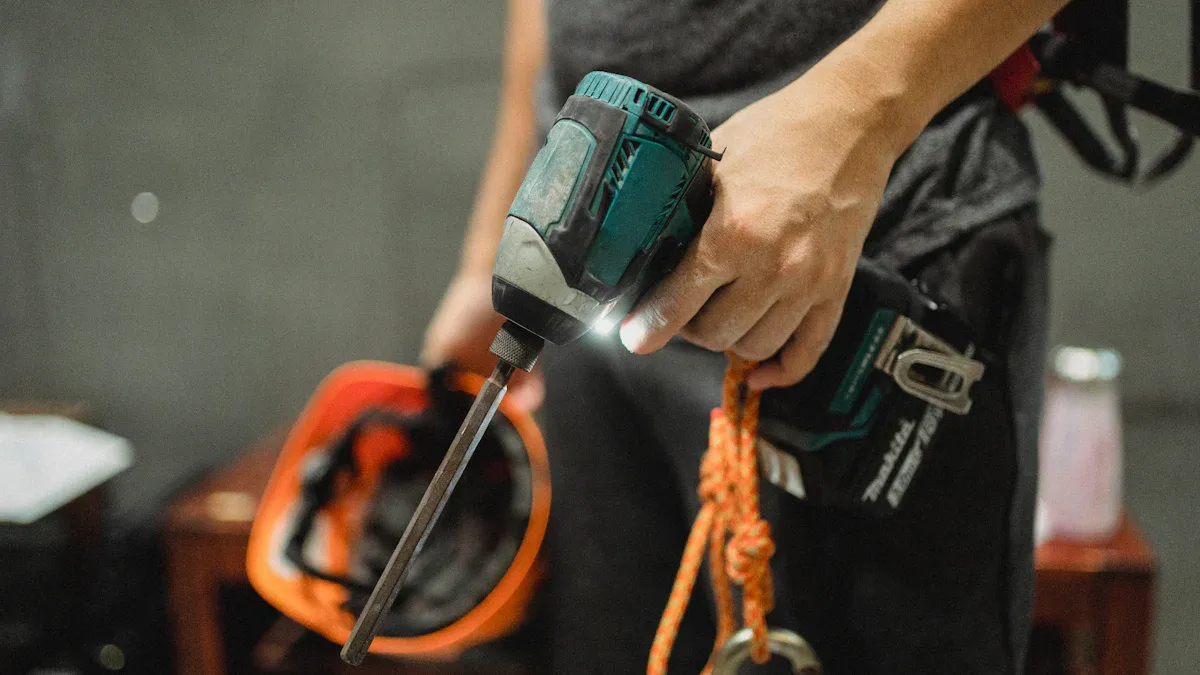
Choosing the right power drills starts with understanding the main types available. Each drill serves a different purpose, so knowing their strengths helps you pick the best tool for your job.
| Type of Power Drill | Description / Usage Data | Real Usage / Market Data / Examples |
|---|---|---|
| Corded Drills | Portable, lightweight; used in drilling and mining operations | Growing demand due to portability and light weight |
| Cordless Drills | Independent from secondary power sources; popular in DIY and professional use | Market growth fueled by lithium-ion batteries and brushless motors |
| Impact Drivers | Provide high torque for fastening applications | Widely used in construction and automotive industries |
| Hammer Drills / Rotary Hammers | Used for rapid demolition and drilling of brittle materials | Growing demand in construction projects |
A hammer drill combines rotary motion with a rapid hammering action. You use this tool to drill into tough materials like brick, stone, or concrete. The hammering mechanism helps break up the surface, making it easier for the bit to penetrate. Many professionals choose a corded hammer drill for heavy-duty work because it delivers consistent power. MINGPU offers corded power tools designed for demanding tasks, giving you reliable performance on any job site. If you need to drill into masonry or concrete, a hammer drill is a smart choice.
A cordless drill gives you freedom to move without worrying about power cords. This drill runs on rechargeable batteries, making it ideal for quick jobs around the house or on sites where outlets are hard to find. Advances in battery life and brushless motors mean you get longer run time and more power than ever before. Cordless drills are popular for DIY projects and light construction. If you want a cordless hammer drill, you can now find models that offer both drilling and hammering functions. However, for long or demanding jobs, a corded drill like those from MINGPU may be better.
An impact driver delivers high torque and rapid impacts, making it perfect for driving screws and bolts into dense materials. You will notice that an impact driver is smaller and lighter than most drills, but it packs a punch. The quick-change chuck lets you swap bits fast, which saves time on repetitive tasks. Impact drivers shine in construction and automotive work, where fastening speed and efficiency matter. They maintain speed under load, reducing strain on the motor and extending tool life. If you need to drive long screws or lag bolts, an impact driver is your go-to tool.
A rotary hammer takes power drills to the next level. This tool uses a piston-driven mechanism to deliver much higher impact energy than a standard hammer drill. You use a rotary hammer for drilling large holes in concrete, chiseling, or breaking up stone. Rotary hammers often feature multiple modes, including hammer-only for chiseling. Test data shows rotary hammers can drill holes in concrete up to 28% faster than regular hammer drills. MINGPU’s corded rotary hammers offer vibration control and consistent power, making them ideal for heavy-duty construction and renovation.
Tip: For large projects or continuous use, corded power tools like those from MINGPU provide steady output and never need recharging. Cordless drills offer mobility and convenience, but corded models excel in demanding environments.
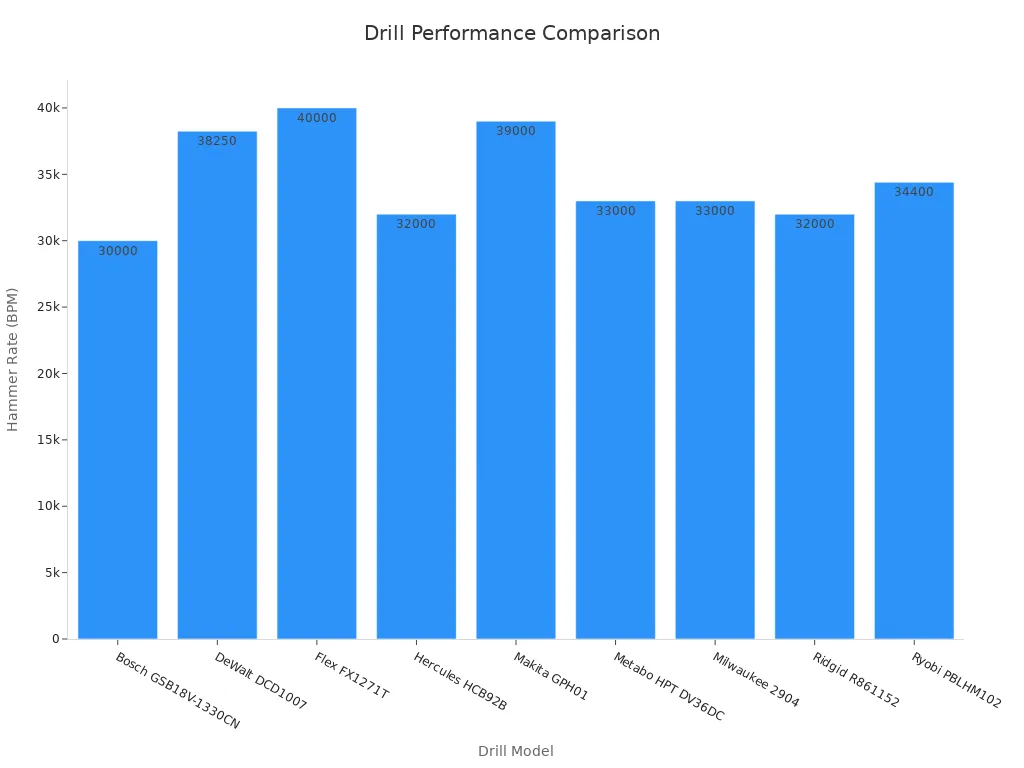
Corded vs. Cordless:
Corded drills and hammers deliver constant power, making them best for long, tough jobs.
Cordless drills and impact drivers give you flexibility and are easy to carry, but you must watch battery life and run time.
When you match the right power drills to your needs, you work faster and safer. Whether you choose a cordless drill for quick fixes or a rotary hammer for concrete, understanding each tool helps you get the job done right.
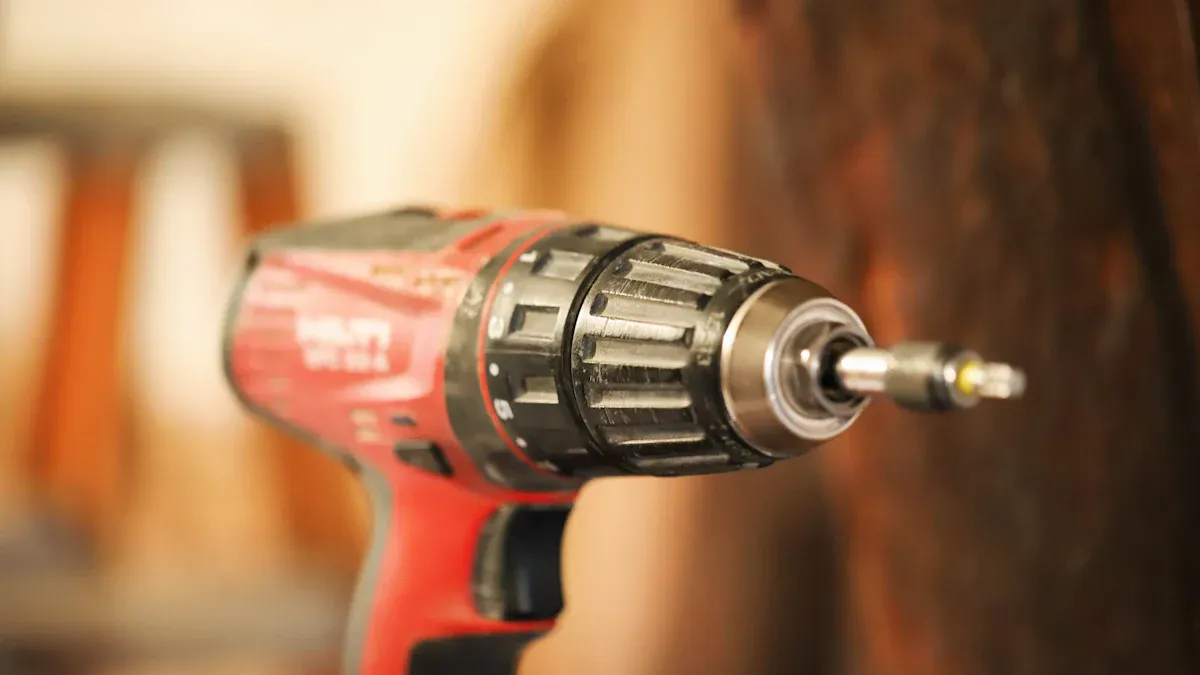
When you choose a hammer drill, you want to focus on the features that make a real difference in your work. Each feature affects how the hammer performs, how comfortable you feel during use, and how well you can handle tough jobs. Let’s break down the most important features to look for.
Power and wattage determine how much force your hammer drill can deliver. Higher wattage means more strength for drilling holes in hard materials like concrete or stone. If you plan to use your hammer for heavy-duty tasks, you should look for models with at least 1000 watts. MINGPU’s corded power tools, for example, offer options like a 1300W rotary hammer and a 1600W demolition hammer. These tools give you the muscle you need for demanding projects. Consumer studies show that higher wattage drills provide better performance and let you work faster, especially when you face tough materials.
Tip: For most home projects, a hammer drill with 600-800W is enough. For professional or industrial use, choose a model with higher wattage to ensure consistent drill performance.
Impact energy and frequency measure how hard and how often the hammer strikes the surface. These two factors decide how quickly you can drill holes and how easily you break through tough materials. A higher impact energy rating means the hammer delivers more force with each blow. Frequency, measured in blows per minute (BPM), tells you how many times the hammer strikes per minute. MINGPU’s rotary hammers offer high impact energy and fast BPM, making them ideal for concrete and masonry.
Here’s a chart that shows how increased frequency leads to better strength gains, which translates to faster and more efficient drilling:
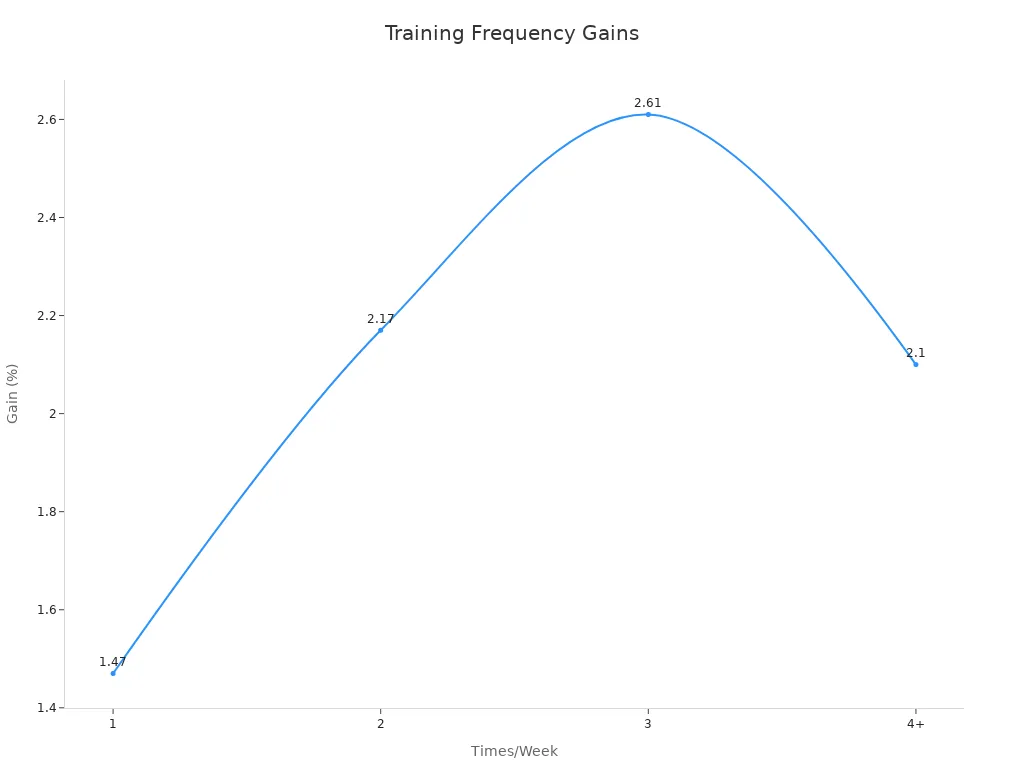
You want a hammer drill that balances both high impact energy and frequency. This combination helps you finish jobs faster and with less effort.
Vibration control is a key feature for comfort and safety. When you use a hammer drill for long periods, strong vibrations can cause fatigue and even injury. Good vibration control reduces the shaking you feel in your hands and arms. MINGPU’s heavy-duty hammers include advanced vibration control systems. These systems help you maintain better handling and reduce the risk of strain. Consumer studies highlight that ergonomic design and vibration suppression improve user satisfaction and productivity. You can work longer and more comfortably with less risk of mistakes.
The chuck type affects what kind of bits you can use and how much power your hammer can deliver. SDS Plus chucks are common and work well for most drilling jobs. They use a 10 mm shank and offer quick bit changes. SDS Max chucks are larger, with an 18 mm shank, and are built for heavy-duty tasks. They hold bigger bits and handle more impact energy. If you need to drill large holes or break up concrete, SDS Max is the better choice. SDS Plus gives you more versatility and lighter weight for everyday use.
Expert reviews show that SDS chucks use a sliding mechanism with ball bearings. This design locks the bit in place and gives you a stronger hold than standard chucks. You also get added safety features like side handles and clutches to prevent kickback. MINGPU offers both SDS Plus and SDS Max options, so you can pick the right hammer for your needs.
Weight and ergonomics play a big role in how easy your hammer drill is to use. A lighter hammer is easier to handle, especially if you need to drill overhead or for long periods. Heavier hammers offer more power but can cause fatigue. Look for a hammer with a balanced design and comfortable grip. MINGPU’s tools use ergonomic handles and smart weight distribution to help you control the hammer and reduce strain. Consumer feedback shows that good ergonomics and proper handling lead to better results and less tiredness after a long day.
Modern hammer drills come with multiple modes and functions. You can switch between drilling, hammer drilling, and chiseling. This flexibility lets you use one hammer for many tasks. Some models include variable speed settings, which help you match the speed and torque to the material. A brushless motor adds even more value by improving efficiency and reducing wear. MINGPU’s rotary hammers feature multiple modes and brushless motor technology, giving you more control and longer tool life.
Note: Always check if your hammer drill offers the modes you need. Variable speed and torque settings help you avoid damaging materials and improve precision.
Here’s a quick table to help you compare the most important features:
| Feature | Why It Matters | What to Look For |
|---|---|---|
| Power (Wattage) | More power for tough materials | 1000W+ for heavy-duty, 600-800W for DIY |
| Impact Energy/Frequency | Faster, easier drilling and breaking | High BPM and Joules rating |
| Vibration Control | Comfort and safety | Advanced vibration reduction |
| Chuck Type | Bit compatibility and power | SDS Plus for versatility, SDS Max for heavy-duty |
| Weight/Ergonomics | Handling and fatigue | Balanced design, ergonomic grip |
| Modes/Functions | Flexibility and precision | Multiple modes, variable speed, brushless motor |
When you focus on these features, you get a hammer drill that matches your needs and delivers top performance. MINGPU’s corded power tools combine high wattage, strong impact, and advanced vibration control, making them a smart choice for both professionals and serious DIY users.
You want a drill that feels comfortable and easy to handle for home improvement and small DIY projects. Lightweight and compact drills work best for tasks like hanging shelves, assembling furniture, or driving screws into wood. Cordless drills have become very popular for home use. Advances in battery technology give you longer run times and faster charging, so you can finish your projects without waiting. Brushless motors and ergonomic designs make these drills efficient and comfortable.
Miniature drills fit well in tight spaces and let you work with precision.
Cordless models remove the hassle of cords and offer great portability.
Variable speed controls help you adjust power for different materials.
Interchangeable battery systems add flexibility and save money.
If you plan to work on small repairs or crafts, a cordless drill is a smart choice. For continuous use or tougher jobs, a corded drill provides steady power. MINGPU corded power tools deliver consistent performance, making them a good option if you want reliability for frequent home tasks.
Tip: Choose a drill with enhanced safety features and a comfortable grip. This helps you work longer without fatigue.
Renovation projects often require more power and endurance. You may need to drill into concrete, brick, or stone, or use a hammer function for demolition. In these cases, a corded hammer or rotary hammer stands out. Corded drills deliver higher torque and never run out of power, which is important for heavy-duty work.
Corded rotary hammers, like those from MINGPU, handle tough materials and long sessions.
High wattage and impact energy let you break through concrete and masonry.
Vibration control features reduce strain during extended use.
If you plan to renovate a basement, install anchors in concrete, or remove tiles, a corded hammer or rotary hammer is the right tool. Cordless models can help with lighter demolition, but corded tools excel in demanding environments.
Professionals and industrial users need tools that can handle daily, intensive use. You want a drill that offers maximum power, durability, and advanced features. Corded drills and hammers remain the top choice for most professionals because they provide consistent torque and can run all day.
MINGPU’s heavy-duty corded hammers and rotary hammers are built for industrial tasks.
Multiple modes, such as drilling, hammer drilling, and chiseling, add versatility.
Advanced vibration control and ergonomic handles improve comfort and safety.
For tasks like drilling large holes in concrete, breaking up stone, or driving screws into dense materials, a corded hammer or rotary hammer gives you the strength and reliability you need. Cordless drills with high-capacity batteries can support some professional tasks, but corded models offer unmatched performance for continuous work.
The material you work with affects your drill choice. Different substrates require specific features for best results.
For wood and drywall, a standard drill or cordless model works well.
For masonry, concrete, or stone, use a hammer drill or rotary hammer with high impact energy.
For metal, choose a drill with variable speed and the right bit type.
For brittle or hard materials, drills with carbide or diamond-tipped bits improve precision and tool life.
When you drill into concrete or asphalt, professional electric core drills with wet-coring capability help cool the bit and remove debris. Electric core drills suit most environments, while gasoline-powered models work best outdoors. For asphalt, diamond coring bits with hard bonding material prevent damage and improve durability.
| Material | Recommended Drill Type | Key Features Needed |
|---|---|---|
| Wood/Drywall | Cordless or Corded Drill | Variable speed, lightweight |
| Masonry/Concrete | Hammer Drill/Rotary Hammer | High impact energy, vibration control |
| Metal | Corded Drill | Variable speed, proper bit |
| Asphalt | Electric Core Drill | Wet-coring, diamond bits |
Note: Always match your drill and bit to the material for the best results and longer tool life.
You should choose a cordless drill for mobility, convenience, and light to medium tasks around the home. Cordless models excel in confined spaces and outdoor projects. For heavy-duty, continuous, or industrial work, a corded drill or hammer like those from MINGPU delivers higher torque and consistent power. Lab tests show cordless drills perform well for driving screws and drilling wood, but corded drills provide more torque for demanding jobs. Price and battery life also influence your decision. Corded drills are often more affordable and never need recharging.
Quick Guide:
Use cordless drills for home repairs, crafts, and light construction.
Use corded drills and hammers for renovation, masonry, and industrial projects.
You want a hammer drill that lasts and performs well. Start by looking at trusted brands with a strong reputation for quality. Brands like MINGPU focus on durability and consistent power. Reliable brands use high-grade materials and advanced engineering. They also offer a wide range of models for different needs. When you choose a reputable brand, you reduce the risk of tool failure and get better long-term value.
Tip: Check customer reviews and ratings before you buy. Real user feedback often reveals how a drill performs in daily use.
A good warranty gives you peace of mind. It shows that the manufacturer stands behind its product. Strong support means you get help quickly if something goes wrong. Many companies now use advanced analytics to improve warranty service. For example:
Some manufacturers use data to spot defects early and recall products before problems spread.
Others analyze warranty claims to find out if failures come from tough job conditions or user mistakes.
Companies track repair data to make service faster and more efficient.
Engineering teams use warranty trends to fix design issues and improve future tools.
Manufacturers adjust warranty terms based on real-world failure rates, balancing coverage and customer trust.
MINGPU offers easy access to support and a global contact network. This ensures you get fast solutions and reliable service.
Accessories can make your hammer drill more versatile. Look for kits that include extra drill bits, chisels, or carrying cases. Some brands provide dust control attachments or side handles for better safety. Having the right accessories saves you time and money. You can start your project right away without extra trips to the store.
| Accessory Type | Why It Matters |
|---|---|
| Extra Bits/Chisels | Increases versatility |
| Carrying Case | Protects your tool |
| Dust Control | Keeps your workspace cleaner |
| Side Handle | Improves grip and safety |
Set a clear budget before you shop. Higher-priced drills often offer more power, better features, and longer life. However, you can find quality options at many price points. Compare features, warranty, and included accessories to get the best value. Remember, a reliable tool saves you money in the long run by reducing downtime and repair costs.
Note: Invest in a drill that matches your needs, not just the lowest price. Quality and support matter as much as cost.
You should always put safety first when using a hammer drill. Start by reading the user manual before you operate any tool. Wear safety goggles, gloves, and hearing protection to shield yourself from dust, debris, and loud noise. Check your work area for hazards like loose wires, wet surfaces, or clutter. Make sure your drill bits are sharp and properly secured in the chuck. Use both hands to control the drill and keep a firm grip at all times.
Tip: Always unplug your corded drill or remove the battery from a cordless model before changing bits or making adjustments.
Stay alert to your surroundings. Never force the drill if it gets stuck. Let the tool do the work. If you notice any unusual sounds or vibrations, stop and inspect the tool right away.
Proper maintenance keeps your hammer drill working safely and efficiently. Clean your drill after each use. Wipe off dust and debris with a dry cloth. Inspect the power cord for cuts or fraying. Lubricate moving parts as recommended by the manufacturer. Store your drill in a dry, cool place to prevent rust and damage.
Check the chuck and bits for wear. Replace worn or damaged parts immediately. Test the safety features, such as the side handle and clutch, to make sure they work correctly. Regular care extends the life of your tool and helps prevent accidents.
Many accidents happen because of simple mistakes. You can avoid most problems by staying aware of the most frequent errors:
Skipping safety gear, like goggles or gloves
Using dull or damaged drill bits
Ignoring the user manual or safety instructions
Working in unsafe environments, such as wet or cluttered areas
Not securing the material before drilling
Overexerting yourself or using the wrong tool for the job
Incident reports often show that mechanical failures, human errors, and procedural lapses lead to near-miss situations. Common risks include being struck by objects, injury from machines, and overexertion during drilling or lifting. You can reduce these risks by following safety protocols and using proper equipment.
Note: Tracking and learning from mistakes helps you work smarter and safer every time you use your hammer drill.
When you choose a hammer, focus on your main tasks and the materials you work with. You should check features like power, impact energy, and vibration control before you buy a hammer. Trusted brands such as MINGPU offer reliable corded hammer options for tough jobs. Make a checklist to compare each hammer and see which fits your needs best. If possible, try different hammer models to find the right balance of comfort and performance.
A hammer drill uses a rapid hammering action for drilling into masonry. A rotary hammer uses a piston mechanism for more powerful impacts. You should use a rotary hammer for heavy-duty concrete work.
Corded drills give you constant power for long jobs. Cordless drills offer mobility and convenience. You should pick corded for heavy-duty tasks and cordless for quick or remote projects.
You should wear safety goggles, gloves, and hearing protection. These items protect you from dust, debris, and loud noise. Always follow the safety instructions in your tool’s manual.
Yes, you can use a hammer drill for wood or metal. Turn off the hammer function and use the right drill bit. This helps you avoid damaging the material or the tool.
Clean your drill after each use. Check the cord and bits for damage. Lubricate moving parts as needed. Store your tool in a dry place. Regular care keeps your drill safe and reliable.
